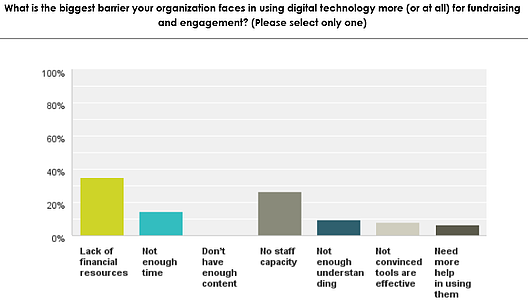 What do nonprofits need to get more comfortable and adept at using digital fundraising and engagement tools? And how can funders help build their capacity to do that?
What do nonprofits need to get more comfortable and adept at using digital fundraising and engagement tools? And how can funders help build their capacity to do that?
These are the questions that the Public Interest Projects—an intermediary that works with hundreds of donors and their grantees working on social justice issues had in mind when they conducted their survey with more than 400 nonprofits and 100 grantmakers.
The survey dug into how (if at all) grantees are using digital fundraising and engagement tools and strategies. It looked at ways that nonprofits can maximize their impact, as well as how grantmakers can actually support capacity building.

Here are a few of the key findings:
- Nearly every small social justice nonprofit is experimenting with online giving.
- Four out of five organizations — about 82% — said they’d never received funding to strengthen their abilities to raise money or mobilize supporters through digital tools.
- The top 2 barriers groups cited in using digital tools to raise money and rally supporters were lack of funding and too few staff members VS. time constraints and limited knowledge.
- The staff member most likely to oversee digital activities is the Executive Director, though most ED's are busy actually running organizations that are overburdened and understaffed. A digital director is a full time job....
- Nonprofits actually said that if they had financial resources for this work, they would use the money to hire more staff members to oversee digital efforts. Of least importance was hiring consultants to develop digital strategies. But, if a nonprofit wants to really move people up the ladder of engagement and develop digital constituents, it's so important to develop digital strategies.
Oftentimes, nonprofits find themselves in a catch 22 position: There aren't enough staff or financial resources to hire staff, but grantmakers don't want to provide grants to organizations until they're doing something, but it's difficult for a nonprofit to do things without staff or funding.
Asked what would sway their decision to give, grantmakers said they wanted to know that digital strategies would be integrated into organizations’ larger organizing, fundraising, and civic engagement efforts and that the money would help expand a group’s reach. They also wanted to know how technology could help strengthen a group’s financial sustainability and reduce its need for continued foundation aid.
A key reason foundations said they didn’t make more digital capacity grants was simply because they didn’t receive enough requests for it.
What barriers have you noticed in your own organizations? And what would help you to overcome these barriers?
You can read the full report and survey responses here.



COMMENTS